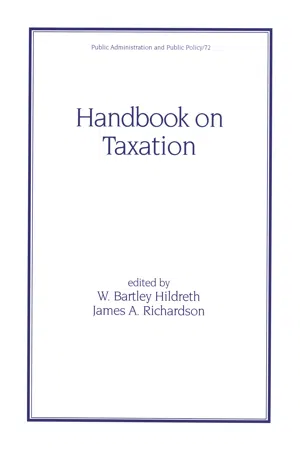Economics
Lump Sum Tax
A lump sum tax is a fixed amount of tax that is imposed regardless of an individual's income or wealth. It is a regressive form of taxation because it takes a larger proportion of income from lower-income individuals compared to higher-income individuals. This type of tax can create a burden for those with lower incomes, as it represents a larger proportion of their overall resources.
Written by Perlego with AI-assistance
4 Key excerpts on "Lump Sum Tax"
- eBook - ePub
The History of Economic Ideas
Economic Thought in Contemporary Context
- Brandon Dupont(Author)
- 2017(Publication Date)
- Routledge(Publisher)
British Prime Minister Margaret Thatcher imposed a lump sum poll tax known as a “community charge” in 1989. The policy was deeply unpopular and contributed to her ouster as prime minister. It was abolished under her successor, John Major.In practice, lump-sum taxes may not work particularly well because they make no distinction between the wealthy and the poor. A poor person’s tax bill under a Lump Sum Tax would be equal to a very wealthy person’s tax bill. Taxpayers obviously have different abilities to pay, and an optimal tax system should take that into consideration.Nobel laureate James Mirrlees made an important contribution in this area with a 1971 paper in which he described the tradeoff between equity and efficiency that makes a Lump Sum Tax impractical. Mirrlees’ approach to optimal taxation assumes that people differ in their ability to earn income and that the social planner who is designing the tax system can observe income levels, but cannot observe the underlying abilities (or the efforts) that generate the income. The inability to observe the underlying abilities or efforts of the potential taxpayers creates a problem: if the tax system is designed to tax the incomes of high-ability people, those people will be discouraged from earning as much income as they could. In formally modeling the efficiency–equity tradeoffs that governments face in reality, and by recognizing the unobserved differences in taxpayer ability, Mirrlees’ framework became the dominant one for the modern economic analysis of taxation.10Mirrlees also concluded that the marginal tax rate on the person with the highest income should, in theory, be zero.Did You Know 6.10
The “marginal tax rate” is the rate that applies to an additional dollar of income. If you are a single filer in the U.S. earning $35,000, you are in the 15 percent tax bracket. That is your marginal tax rate, because you would pay 15 percent of an extra dollar of income as long as you remain in that bracket. But your first $8,925 of taxable income was taxed at a lower rate of 10 percent (since the first tax bracket ranges from $0 to $8,925). You do not, in other words, pay 15 percent of your total $35,000 income since the first $8,925 of that income was taxed at a lower rate. - eBook - ePub
- Enrico Colombatto(Author)
- 2016(Publication Date)
- Routledge(Publisher)
The previous sections have underscored four fundamental results. First, except for situations in which the tax is actually a price (see the example of pollution, above), the desirability of taxation ultimately depends on the satisfaction generated by the tax-financed public expenditure and on the deadweight losses taxation provokes. Second, the tax is generally paid by all the agents involved in a transaction, regardless of the identities of the tax target and of the tax collector. Third, the burden of the tax falls on those who cannot avoid it: consumers with a rigid demand and producers with a rigid supply. This is not without consequences, though. For example, the prospect of a heavy tax burden encourages producers to employ inputs that allow an elastic supply, and to adopt techniques characterised by limited fixed (sunk) costs, even when this is not the cost-minimising strategy. Fourth, the only form of efficient – although not necessarily fair – taxation pertains to actions that the individual carried out in the past, but only if the tax does not cause the individual to revise his subsequent behaviour.We bring our analysis of taxation to a close by pointing out that simplicity has caused us to limit our inquiry to the economics of proportional taxation, which corresponds to a constant tax rate on the transaction or on income. Although proportional taxation plays an important role in many modern tax systems – for example, the value-added tax features a constant tax rate, even if the incomes of those who actually pay the tax are not hit according to a proportional criterion – it is undeniable that many areas of taxation follow different criteria: progressive taxation (the average tax rate increases with the size of the taxable assets) and regressive taxation (the tax rate decreases with the size of the taxable asset). For example, individuals are usually subject to a progressive income tax, while professionals paying the government an annual lump-sum tax in order to practise are subject to a regressive tax.Although most modern tax systems are more or less progressive, the debate on the pros and cons of these systems – progressive, proportional and regressive taxation – is old and there is no a priori way of claiming that one is preferable to the others. By and large, the verdict depends on one's notion of justice. Although this is not the suitable place to take sides and engage in philosophical debate, it seems useful to offer some elements that might help the reader to develop his own ideas and opinions. - eBook - ePub
- W.Bartley Hildreth(Author)
- 2019(Publication Date)
- Routledge(Publisher)
The current debate on federal income tax reform includes an examination of the flat tax. This proposal suggests a single rate for all taxpayers, but this single tax rate is not applicable until a certain threshold of income. The single rate may appear to be the epitome of tax simplicity, but the complications of the federal income tax code are not the multiple tax rates, but rather the complications of defining the tax base. A single federal income tax rate may be appropriate for many reasons, but by itself does not lead to tax simplification. The flat tax proposals lead to tax simplification only if such a proposal leads to a tax base without exemptions and exclusions. The flat tax proposals may lead to tax simplification if these proposals supplant the thinking that the tax code can be used to encourage certain types of behavior and discourage other types. Even under the most optimistic assumptions, however, there will be a long list of instructions in defining taxable income to which you apply either a single rate or several rates of taxation, depending on a person’s income status.Tax simplification can also merely focus on the individual. For example, the sales tax is very simple from the perspective of the individual paying the sales tax at the retail level. The person does not have to keep any records; the individual does not have to fill out any forms at the end of the year; the person only has to pay the tax every time that he or she buys a taxable item. Businesses have to collect the tax, however. They have to separate those items that are taxable from those items that are not taxable or those items that are taxable at different rates. A business that pays sales tax on its business transactions must decide which of these transactions are subject to the sales tax. State and local governments will audit these businesses to make sure that they are complying with the law.Tax simplicity is an important property or goal of the federal, state, or local tax structures, however, it is also a relative concept. The simplest tax might be a head tax, but this is not necessarily the most equitable tax. A tax on wages and salaries is more simple than a tax on all forms of income, but such a solution is not necessarily equitable or foolproof. There is no doubt that if a government only taxed wages and salaries every taxpayer would try to convert his or her wages and salary into some other form of income. - eBook - ePub
Public Sector Revenue
Principles, Policies and Management
- Alberto Asquer(Author)
- 2017(Publication Date)
- Routledge(Publisher)
As a matter of fact, sometimes taxpayers are required to incur additional costs on the top of the taxes, in such forms as, for example, money paid to accountants to comply with tax rules and regulations and time spent to carry out tasks to fulfil the tax levy. • Efficiency. As Smith (1776) maintained, ‘Every tax ought to be so contrived as to take out of the pockets as little as possible, over and above that which it brings into the public treasury of the state.’ This principle relates to the trade-off between the benefit that taxation brings to fiscal administration – and, relatedly, to the possibility to implement public policies and programmes – on the one hand, and the cost that taxation puts on taxpayers on the other one. As we shall discuss below, taxation results in a net cost to the economy, the so-called ‘deadweight loss’. Tax systems should minimise the overall deadweight loss to the economy. The application of these principles results in various practical challenges. The principle of fairness, for example, calls into play the distinction between horizontal and vertical equity. Horizontal equity means that taxpayers under similar economic conditions should pay the same amount of taxes (Musgrave, 1990). Vertical equity means that taxpayers under better economic conditions should pay more taxes than those in worse economic conditions (Pigou, 1912). In practice, these criteria are not always implemented. In many tax systems, income may be taxed differently depending on the source; for example, a certain amount of income from salary may be taxed at a different (typically higher) rate than the same amount of income that originates as a return on financial assets
Index pages curate the most relevant extracts from our library of academic textbooks. They’ve been created using an in-house natural language model (NLM), each adding context and meaning to key research topics.
Explore more topic indexes
Explore more topic indexes
1 of 6
Explore more topic indexes
1 of 4



